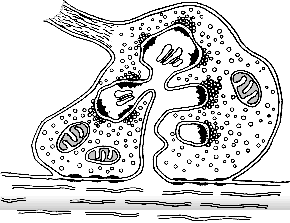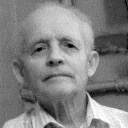
Stochastic models of invaginating spine synapse
with Byzov's ephaptic feedback

A feedback due to an ephaptic effect of the synaptic current on a presynaptic
terminal was originally hypothesised by A.L.Byzov for invaginating chemical
synapses between photoreceptors and secondary neurons in the retina1.
The hypothesis suggests that transmitter release is determined by a potential
at the presynaptic membrane. This potential may deviate from the resting potential
of the presynaptic neuron in case of deeply invaginating synapses due to the
potential drop across the synaptic cleft produced by the postsynaptic current.
Therefore, the latter influences the potential at the presynaptic membrane.
This creates a feedback, which is positive in case of excitatory chemical synapses.
The ephaptic feedback hypothesis provides explanations for some features of synaptic
transmission between neurons with sustained activity2-4.
The hypothesis, even without strict formalisation, appeared also to be useful for
the explanation of some effects in spiking neurons5.
Here, we propose two two formalised stochastic models of synaptic transmission incorporating
the ephaptic feedback.
 The synapse was supposed to contain several release sites. Neurotransmitter release
was taken to be random, the release probability being considered exponentially
dependent on the potential at the presynaptic membrane, Vp .
Each site was suggested to release only one transmitter quantum per each presynaptic spike.
The action of the intrasynaptic ephaptic feedback was simulated
according to the following scenario. The arrival of a spike depolarizes
a presynaptic terminal. Consequently the release probability of all sites
abruptly increases, and at some time point, some site releases a portion
of transmitter. The transmitter gets bound with receptors at the subsynaptic
membrane and activates receptor channels. This generates an excitatory postsynaptic
current (EPSC) flowing through the subsynaptic membrane and creating a potential
drop across the synaptic cleft. The value of the potential drop can be calculated
from the value of the potential that clamps the postsynaptic neuron,
V2 , and from the parameters of the voltage divider
(the subsynaptic resistance, Rs , of the receptor zone under
the release sites at the given moment and the resistance of the synaptic cleft,
Rg).
In case the postsynaptic neuron is hyperpolarized, the potential drop across
the synaptic cleft causes an additional depolarization of the presynaptic membrane,
thus increasing the release probability of the other sites.
Such positive feedback evokes a growing depletion of sites that is limited in time
by the duration of the spike in the presynaptic terminal. The larger the postsynaptic
hyperpolarization, the larger number of presynaptic sites releases transmitter during
the spike. On the contrary, a depolarization of the postsynaptic neuron results in a
hyperpolarization of the presynaptic membrane thus decreasing neurotransmitter release.
The synapse was supposed to contain several release sites. Neurotransmitter release
was taken to be random, the release probability being considered exponentially
dependent on the potential at the presynaptic membrane, Vp .
Each site was suggested to release only one transmitter quantum per each presynaptic spike.
The action of the intrasynaptic ephaptic feedback was simulated
according to the following scenario. The arrival of a spike depolarizes
a presynaptic terminal. Consequently the release probability of all sites
abruptly increases, and at some time point, some site releases a portion
of transmitter. The transmitter gets bound with receptors at the subsynaptic
membrane and activates receptor channels. This generates an excitatory postsynaptic
current (EPSC) flowing through the subsynaptic membrane and creating a potential
drop across the synaptic cleft. The value of the potential drop can be calculated
from the value of the potential that clamps the postsynaptic neuron,
V2 , and from the parameters of the voltage divider
(the subsynaptic resistance, Rs , of the receptor zone under
the release sites at the given moment and the resistance of the synaptic cleft,
Rg).
In case the postsynaptic neuron is hyperpolarized, the potential drop across
the synaptic cleft causes an additional depolarization of the presynaptic membrane,
thus increasing the release probability of the other sites.
Such positive feedback evokes a growing depletion of sites that is limited in time
by the duration of the spike in the presynaptic terminal. The larger the postsynaptic
hyperpolarization, the larger number of presynaptic sites releases transmitter during
the spike. On the contrary, a depolarization of the postsynaptic neuron results in a
hyperpolarization of the presynaptic membrane thus decreasing neurotransmitter release.
Quantitative manifestations of the intrasynaptic ephaptic feedback depend on specific values
of parameters of the synapse. The main purpose of the project was to develop computer models
of the intrasynaptic ephaptic feedback, in which a user can
edit the parameter values and observe their influence on behavior of the synapse.
Two such models are currently under construction. The models are designed as Windows
applications, their preliminary versions being available here:
 Application eqUNO is destined as an initial step and is recommended
for inexperienced users. It simulates responses of the synapse with ephaptic feedback
to arrival of a single spike to a presynaptic terminal.
Application eqUNO is destined as an initial step and is recommended
for inexperienced users. It simulates responses of the synapse with ephaptic feedback
to arrival of a single spike to a presynaptic terminal.
 Application eqDUO expands the ephaptic feedback model for
the case of paired presynaptic stimulation. It is recommended for advanced users only.
It contains twice as many windows and twice as many parameters for editing as compared to
eqUNO. Thus, it includes parameters describing temporary changes in release probability
resulting from previous transmitter release which are responsible for paired pulse depression
and facilitation.
Application eqDUO expands the ephaptic feedback model for
the case of paired presynaptic stimulation. It is recommended for advanced users only.
It contains twice as many windows and twice as many parameters for editing as compared to
eqUNO. Thus, it includes parameters describing temporary changes in release probability
resulting from previous transmitter release which are responsible for paired pulse depression
and facilitation.
Though the models pursue mainly didactic purposes, they give a number of predictions
that could not be easily envisioned and can be tested in physiological experiments.
Literature
1.
Byzov A.L. and Trifonov Yu.A. (1968)
Hypothesis on the electrical feedback in synaptic transmission between
photoreceptors and second-order neurones in vertebrate retina (in Russian).
In: Synaptic Processes (ed. P.G.Kostyuk). Kiev: "Naukova Dumka", pp. 231-248
2.
Byzov A.L. and Shura-Bura T.M. (1986)
Electrical feedback mechanism in the processing of signals in the outer
plexiform layer of the retina. Vision Res. 26, 33-34
3.
Maximov V.V. and Byzov A.L. (1996)
Horizontal cell dynamics: What are the main factors? Vision Res. 36, 4077-4087
4.
Byzov A.L. and Maximov V.V. (1998)
Electrical feedback in chemical synapses (in Russian).
Russian J. Physiol. 84, 1074-1084
5.
Voronin L.L., Byzov A.L., Kleschevnikov A.M., Kozhemyakin M., Kuhnt U. and Volgushev M. (1995)
Neurophysiological analysis of long-term potentiation in mammalian brain.
Behav. Brain Res. 66, 45-52
6.
Voronin L.L. (1999/2000) Intrasynaptic ephaptic feedback in central synapses.
Neurosci. Behav. Physiol. 30, 575-585 (Translated from Russian J. Physiol.
85, 729-742)
7.
Voronin L.L., Volgushev M., Sokolov M., Kasyanov A., Chistiakova M, and Reymann K.G, (1999).
Evidence for an electrical feedback in cortical synapses: postsynaptic hyperpolarization
alters the number of response failures and quantal content. Neuroscience 92, 399-405
8.
Berretta N., Rossokhin A.V., Kasyanov A.M., Sokolov M.V., Cherubini E. and Voronin L.L. (2000)
Postsynaptic hyperpolarization increases the strength of AMPA mediated synaptic
transmission at large synapses between mossy fibers and CA3 pyramidal cells.
Neuropharmacology 39, 2288-2301.
9.
Kasyanov A.M., Maximov V.V., Byzov A.L., Berretta N., Sokolov M.V., Gasparini S., Cherubini E., Reymann K. and Voronin L.L. (2000)
Differences in amplitude-voltage relations between minimal and composite mossy fibre
responses of rat CA3 hippocampal neurons support the existence of intrasynaptic
ephaptic feedback in large synapses. Neuroscience 101, 323-336
Questions and comments to
Back to IITP Laboratory 8 Activity Page
Back to IITP Projects Page ( IITP russian Projects Page )
Last Update: 22 August, 2003
 The synapse was supposed to contain several release sites. Neurotransmitter release
was taken to be random, the release probability being considered exponentially
dependent on the potential at the presynaptic membrane, Vp .
Each site was suggested to release only one transmitter quantum per each presynaptic spike.
The action of the intrasynaptic ephaptic feedback was simulated
according to the following scenario. The arrival of a spike depolarizes
a presynaptic terminal. Consequently the release probability of all sites
abruptly increases, and at some time point, some site releases a portion
of transmitter. The transmitter gets bound with receptors at the subsynaptic
membrane and activates receptor channels. This generates an excitatory postsynaptic
current (EPSC) flowing through the subsynaptic membrane and creating a potential
drop across the synaptic cleft. The value of the potential drop can be calculated
from the value of the potential that clamps the postsynaptic neuron,
V2 , and from the parameters of the voltage divider
(the subsynaptic resistance, Rs , of the receptor zone under
the release sites at the given moment and the resistance of the synaptic cleft,
Rg).
In case the postsynaptic neuron is hyperpolarized, the potential drop across
the synaptic cleft causes an additional depolarization of the presynaptic membrane,
thus increasing the release probability of the other sites.
Such positive feedback evokes a growing depletion of sites that is limited in time
by the duration of the spike in the presynaptic terminal. The larger the postsynaptic
hyperpolarization, the larger number of presynaptic sites releases transmitter during
the spike. On the contrary, a depolarization of the postsynaptic neuron results in a
hyperpolarization of the presynaptic membrane thus decreasing neurotransmitter release.
The synapse was supposed to contain several release sites. Neurotransmitter release
was taken to be random, the release probability being considered exponentially
dependent on the potential at the presynaptic membrane, Vp .
Each site was suggested to release only one transmitter quantum per each presynaptic spike.
The action of the intrasynaptic ephaptic feedback was simulated
according to the following scenario. The arrival of a spike depolarizes
a presynaptic terminal. Consequently the release probability of all sites
abruptly increases, and at some time point, some site releases a portion
of transmitter. The transmitter gets bound with receptors at the subsynaptic
membrane and activates receptor channels. This generates an excitatory postsynaptic
current (EPSC) flowing through the subsynaptic membrane and creating a potential
drop across the synaptic cleft. The value of the potential drop can be calculated
from the value of the potential that clamps the postsynaptic neuron,
V2 , and from the parameters of the voltage divider
(the subsynaptic resistance, Rs , of the receptor zone under
the release sites at the given moment and the resistance of the synaptic cleft,
Rg).
In case the postsynaptic neuron is hyperpolarized, the potential drop across
the synaptic cleft causes an additional depolarization of the presynaptic membrane,
thus increasing the release probability of the other sites.
Such positive feedback evokes a growing depletion of sites that is limited in time
by the duration of the spike in the presynaptic terminal. The larger the postsynaptic
hyperpolarization, the larger number of presynaptic sites releases transmitter during
the spike. On the contrary, a depolarization of the postsynaptic neuron results in a
hyperpolarization of the presynaptic membrane thus decreasing neurotransmitter release.

